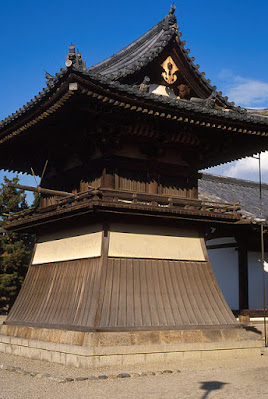Haiku Travels
Horyuji (Nara)
Masaoka Shiki (1867-1902) wrote this haiku in the autumn of 1895 and gave it the title 'Stopping at a teashop at Horyuji Temple.' It is deservedly one of his most famous poems. Horyuji, of course, is one of Japan's oldest and grandest temples, a great treasury of 7th c. art. It possesses the oldest wooden buildings in the world. Horyuji is intimately associated with Prince Shotoku, an almost completely legendary member of the imperial court in the Asuka period (around 600 CE), who soon after his death became the object of a devotional cult that gathered strength in the Japanese middle ages.when biting in a persimmon
the bell booms
Horyuji templekaki kueba | kane ga narunari | Horyuji
柿くへば鐘が鳴るなり法隆寺Shiki
[The Bell Tower of Horyuji]
Shiki was on his way from Matsuyama to Tokyo in 1895, and probably visited Nara on October 24 to 26. He stayed in an inn close to Todaiji temple in central Nara, and had asked the maid to bring him a bowl of persimmons, his favorite fruit. She peeled and cut the fruit for him, and when he started eating, he heard the temple bell of Todaiji - an "aha" moment that he caught in a haiku. The following morning he took a rickshaw to visit Horyuji temple, located about 20 km south of Nara, in Ikaruga. He was so impressed by Horyuji that he changed the temple name in the persimmon-haiku from Todaiji to Horyuji (both names luckily contain 5 syllables). The founding dates of Horyuji and Todaiji both go back to the 7th and 8th centuries, but Todaiji was several times destroyed by the fires of war, so that the present buildings mainly date from the 17th c. Those of Horyuji once burnt down in the 7th c., but by 711 the temple was rebuilt and that temple still stands today. And in contrast to Horyuji which is a devotional temple dedicated to the popular Prince Shotoku, the purported "father of Japanese Buddhism," Todaiji was a much more severe official state temple.
[Horyuji]
Kaki, Japanese persimmon, is the emblematic fruit of autumn. It is a sweet, slightly tangy fruit. When you travel in Japan in the fall, you can see the bright orange fruit hanging in the trees, against a blue sky. And in winter strings of persimmons hang under the eaves of the farmhouses to dry - a beautiful, seasonal decorative effect (see my blog article on kaki for more information).
The Japanese temple bell (bonsho or tsurigane) serves to summon the monks to prayer and to demarcate periods of time. Rather than containing a clapper, Japanese temple bells are struck from the outside, using a beam suspended on ropes. The bells' penetrating and pervasive tone, with its long reverberating echo, carries over considerable distances. Japanese temple bells are often struck at the New Year a symbolical 108 times to wash that number of attachments away. Some Western commentators associate the booming temple bell with a death knell (presumably because of Shiki's tuberculosis which in a few year's time would carry him to the grave), but that is culturally wrong - the ringing of (church) bells at a funeral is a Western custom and has nothing to do with Japanese culture.
[Example of a temple bell: Onjoji Temple, Otsu]
Shiki's treatment of the solemn establishment of Horyuji is almost jocular and certainly very modern. Buddhism is ultimately concerned with causes and results, actions and their resulting karma. The ideal Buddhist situation is not to have any conscious actions and stop the Wheel of Karma that leads to countless rebirths and thus suffering. What then is the link between setting one's teeth in a persimmon and the resulting boom of Horyuji's temple bell?
[The haiku stone (kuhi) in Horyuji inscribed with Shiki's poem]
Shiki wrote many more persimmon haiku, as this was his favorite fruit. Here is an anthology:
a persimmon made me remember
the face of the maid
at that inn in Nara
kaki ni omou | Nara no hatago no | gejo no kao
weary of reading
by lamplight I peel
a persimmon at midnight
sho ni umite | toka ni kaki wo | muku hanya
after judging
three thousand haiku
two persimmons
sanzen no | haiku wo kemishi | kaki futatsu
[Hoshigaki]
dried persimmons
hanging behind the bath
in front of the shed
hoshigaki ya | yudono no ushiro | naya no mae
putting my teeth into it
the ripe persimmon
has smudged my beard
kaburitsuku | jukushi ya hige wo | yogoshikeri
also for eating persimmons
this year - I'm afraid -
will be my last
kaki kuu mo | kotoshi bakari to | omoikeri
"After I am dead"
tell them
I was a persimmon eater
who loved haiku
kaki kui no | haiku konomishi to | tsutau beshi
The haiku stone stands at the edge of the pond in front of the Shoryoin Hall of Horyuji.
From Kintetsu or JR Nara station 50-min by bus to Horyuji bus stop. Or a 15-min walk from JR Horyuji Station (which is 11 min by train from JR Nara Station).
See about Shiki: Masaoka Shiki, Selected Poems, by Burton Watson (Columbia U.P.); The Winter Sun Shines in: A Life of Masaoka Shiki, by Donald Keene (Columbia U.P.); Masaoka Shiki: His Life and Works, by Janine Beichman (Kodansha International); If Someone Asks..., Masaoka Shiki's Life and Haiku, Matsuyama Municipal Shiki-Kinen Museum.
About Horyuji, see The Lucky Seven, Early Horyuji and Its Time by J. Edward Kidder, Jr (International Christian University, Tokyo).
About Prince Shotoku, see Shotoku, Ethnicity, Ritual, and Violence in the Japanese Buddhist Tradition, by Michael I. Como (Oxford U.P.).
The photos of Horyuji and Onjoji are by Ad Blankestijn.
The others via Wikimedia.





